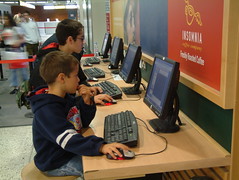Independent School Magazine, Summer 2004
E-Learning: Lessons from Higher Education, by Gene I. Maeroff
A Virtual Reality: The Growing World of Online Learning, by Bruce and Augusta Droste
Both articles give advice to schools about why to offer online learning. (Do not do it for the profit, but instead to offer alternative ways to deliver learning.) Both articles address the question, "Does online learning offer a better way to learn?" Mearoff suggests that this question implies that "being equal is not enough," (p. 69). Droste and Droste cite data from their Virtual High School that their online students show a higher level of achievement. In fact, most research that has been done comparing online learning with face to face learning has concluded with no significant statisitical difference. If all else is equal, why not offer more ways to access learning. Both articles cite terrific examples of online learning, such as online courses for high school age children of migrant workers so they can participate as they move around, allowing students to sign up for courses that small schools can't offer so the school can keep its accreditation, allowing students who are ill to continue to participate in class, offering high level science courses that student would not be able to access otherwise, etc.
But what I came back to again and again as I read both articles was this question: can e-learning teach us anything we can use in the traditional face to face classroom? My answer is a definitive yes. Over the next few days, I will post some of these e-learning strategies here.
Put responsibility on the learner
First, online learning puts more responsibility for learning on the learner. Online learning places "the destiny of students in their own hands," (Maeroff, p. 68). Online students must be disciplined to check and interact with new content on their own time. It is up to them to know when things are due. There is no teacher at the front of the room reminding them every day when to do what. The author does admit that an irresponsible learner may have a problem with this. But, in a face to face class, you can have the best of both worlds. We can place more responsibility on our learners, but still be in a situation where we can intervene if needed.
It is always a challenge for me to place responsibility on the learner, even though I know the benefits for learning. It usually comes down to lack of time. What are your strategies for placing more responsibility on students and still meeting your curriculum deadlines? Please share.


1 comment:
Hi, Heather,
When I took my first online class, I really missed the human contact. I can't tell you how happy I was when coincidentally two other students and I met. The article mentions that many students thrive in the anonymity of online courses. Other students, like myself, would like, at least, to occasionally plug the web cam in lieu of face to face interaction.
Manuel
Post a Comment